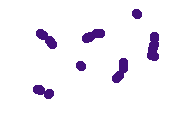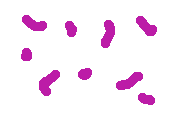











The Gram stain is an essential part of laboratory diagnosis of bacterial infections. A Gram stain can be performed on material (tissues, cells, fluids) recovered from the patient or it can be performed on smears prepared from cultures.
The Gram stain makes use of a dye called crystal violet which is applied to the glass slide with the material to be tested. The crystal violet is followed by an iodine solution, which will cause all bacteria (and fungi) present to stain purple-blue. Next, the slide is decolorized by adding alcohol, which will remove the crystal violet-iodine stain from gram-negative organisms, while leaving gram-positive organisms the same purple-blue color. An additional counterstain, typically safranin, can be added to stain the gram-negative organisms pink and contrast with the gram-positive organisms.
Below are diagrams of many of the types of organisms that can be seen with the Gram stain. Move the cursor over the image and the description will appear in the status bar at the bottom of the screen.

| 
| 
|

| 
| 
|

| 
| 
|

| 
| 
|
Below are links to actual Gram stains of several types of organisms.

|